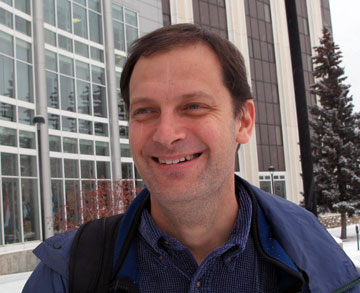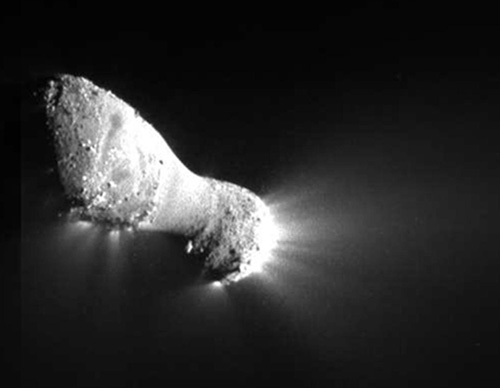|

Alaska Science Alaskan has close encounter with comet Hartley 2 November 13, 2010
A telescopic imager Hampton had helped design more than a decade ago captured the glowing knuckles and smooth waistline of the comet Hartley 2, which is perhaps a fragment of the formation of the solar system 4.5 billion years ago. The recent portrait of the comet is even more impressive considering it was like snapping an image of Seward, while hovering above Fairbanks. Hampton, who teaches physics classes at the University of Alaska Fairbanks and works at the Geophysical Institute’s Poker Flat Research Range, was invited to California to be part of the continued operation of a pickup-truck-sized-spacecraft that became a celebrity five years ago when it slung a copper bullet into the heart of comet Tempel 1. At that time, Hampton was working at Ball Aerospace & Technologies Corp. in Boulder, Colo., as part of the team that designed the electronic eyes for a craft launched into space to perform the “Deep Impact” mission. After the success of Deep Impact, “we still had half of our propellant left,” Hampton said. The instruments on board the spacecraft were still working, and NASA agreed to fund another comet chase. Hartley 2 is a dirty snowball of ice and gases that were a fuzzy dot more than 11 million miles from Earth when astronomer Malcolm Hartley first saw it back in 1986. With much foresight, researchers fired the rocket motors on the Deep Impact spacecraft five years ago to position its orbit around the sun for a close pass with Hartley 2. “It’s not often you get to use spacecraft for a second purpose,” said Hampton, who returned to Alaska to work at the Geophysical Institute in 2006 after earning his doctorate there a decade earlier. In early November 2010, the countdown was on. Hampton’s Fairbanks coworkers took over teaching his classes. Hampton flew down to Los Angeles, drove to JPL, and manned a seat in the Control Room. His job was to make sure the instruments aboard the spacecraft were working, and to come up with a plan if they weren’t. “Considering the instruments have been running for over five years now it’s a pretty cushy job,” he said in an e-mail a few days before the action.
An image of comet Hartley 2 from NASA’s EPOXI mission. The image was taken as the spacecraft flew by the comet on November 4, 2010. According to NASA, the Hartley 2 comet is 1.4-miles-long and is composed of water ice, carbon dioxide ice and silicate dust. The name “EPOXI” is a combination of the names Extrasolar Planet Observations and Characterization (EPOCh) and Deep Impact Extended Investigation (DIXI). Hampton pulled long shifts in the Control Room as the spacecraft neared Hartley 2. Because the ship’s original configuration was for a different comet in a different location, its communication antennas couldn’t always be aimed at the blue ball of Earth when its imagers were locked on the comet. “We did the do-si-do for a while, moving the spacecraft to point its instruments at the comet, then shifting back to point the antenna here,” Hampton said. As the spacecraft neared its closest approach, 434 miles from the comet, the team halted the dance and turned the ship’s two visible-light and single infrared imagers at Hartley 2. The download of the data captured on the spacecraft’s computers could wait, and so did the science team. “For the last 18 hours, it was actually pretty boring,” Hampton said. After the close pass, it still took a few hours to receive the data from space that would become a new portrait of a comet. Hampton had been talking with a friend who traveled to JPL for the event, and then excused himself to jog back to the rest of the science team just as the whoop went up in response to the first images. “We’ve seen five comet nuclei now, and they’re all different,” Hampton said from the Jet Propulsion Laboratory a day after the comet images were released. “The big thing is how active this one is. There’s no doubt about where the source of the jets (that give the comet a fuzzy appearance) are coming from - the really rough two ends of it. We’re going to learn a lot more about comets from this.” The Deep Impact spacecraft is now in an orbit around the sun that makes more comet chasing impractical, but Hampton said it might perform another encore. “It still has about 10 years of fuel,” Hampton said, adding that NASA will decide on the future of the spacecraft. “Anything you can observe from a telescope is fair game.” Hampton is not sure if he will be involved in a future mission, but he’s worked on the spacecraft since before workers turned the first bolt. “It’s pretty unique to work from the proposal to the operations stage,” he said. “I feel very lucky that I get to do all these fun things and get paid to do it.”
This column is provided as a public service by the Geophysical Institute, Publish A Letter in SitNews Read Letters/Opinions
|
||

